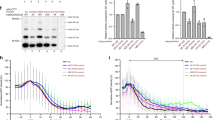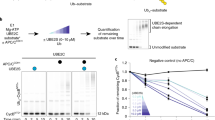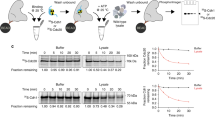Abstract
Ubiquitin-mediated proteolysis of securin and mitotic cyclins is essential for exit from mitosis. The final step in ubiquitination of these and other proteins is catalysed by the anaphase-promoting complex (APC), a multi-subunit ubiquitin-protein ligase (E3). Little is known about the molecular reaction resulting in APC-dependent substrate ubiquitination or the role of individual APC subunits in the reaction. Using a well-defined in vitro system, we show that highly purified APC from Saccharomyces cerevisiae ubiquitinates a model cyclin substrate in a processive manner. Analysis of mutant APC lacking the Doc1/Apc10 subunit (APCdoc1Δ) indicates that Doc1 is required for processivity. The specific molecular defect in APCdoc1Δ is identified by a large increase in apparent KM for the cyclin substrate relative to the wild-type enzyme. This suggests that Doc1 stimulates processivity by limiting substrate dissociation. Addition of recombinant Doc1 to APCdoc1Δ fully restores enzyme function. Doc1-related domains are found in mechanistically distinct ubiquitin-ligase enzymes and may generally stimulate ubiquitination by contributing to substrate–enzyme affinity.
This is a preview of subscription content, access via your institution
Access options
Subscribe to this journal
Receive 12 print issues and online access
$209.00 per year
only $17.42 per issue
Buy this article
- Purchase on Springer Link
- Instant access to full article PDF
Prices may be subject to local taxes which are calculated during checkout







Similar content being viewed by others
References
Hershko, A. & Ciechanover, A. The ubiquitin system. Annu. Rev. Biochem. 67, 425–479 (1998).
Pickart, C. M. Mechanisms underlying ubiquitination. Annu. Rev. Biochem. 70, 503–533 (2001).
Scheffner, M., Nuber, U. & Huibregtse, J. M. . Protein ubiquitination involving an E1–E2–E3 enzyme ubiquitin thioester cascade. Nature 373, 81–83 (1995).
Peters, J. M. The anaphase-promoting complex: proteolysis in mitosis and beyond. Mol. Cell 9, 931–943 (2002).
Harper, J. W., Burton, J. L. & Solomon, M. J. . The anaphase-promoting complex: it's not just for mitosis any more. Genes Dev. 16, 2179–2206 (2002).
Schwab, M. et al. Yeast Hct1 recognizes the mitotic cyclin Clb2 and other substrates of the ubiquitin ligase APC. EMBO J. 20, 5165–5175 (2001).
Burton, J. L. & Solomon, M. J. D box and KEN box motifs in budding yeast Hsl1p are required for APC-mediated degradation and direct binding to Cdc20p and Cdh1p. Genes Dev. 15, 2381–2395 (2001).
Pfleger, C. M., Lee, E. & Kirschner, M. W. Substrate recognition by the Cdc20 and Cdh1 components of the anaphase-promoting complex. Genes Dev. 15, 2396–2407 (2001).
Hilioti, Z. et al. The anaphase inhibitor Pds1 binds to the APC/C-associated protein Cdc20 in a destruction box-dependent manner. Curr. Biol. 11, 1347–1352 (2001).
Leverson, J. D. et al. The APC11 RING-H2 finger mediates E2-dependent ubiquitination. Mol. Biol. Cell 11, 2315–2325 (2000).
Gmachl, M. et al. The RING-H2 finger protein APC11 and the E2 enzyme UBC4 are sufficient to ubiquitinate substrates of the anaphase-promoting complex. Proc. Natl Acad. Sci. USA 97, 8973–8978 (2000).
Tang, Z. et al. Apc2 Cullin protein and Apc11 RING protein comprise the minimal ubiquitin ligase module of the anaphase-promoting complex. Mol. Biol. Cell 12, 3839–3851 (2001).
Grossberger, R. et al. Characterization of the DOC1/APC10 subunit of the yeast and the human anaphase-promoting complex. J. Biol. Chem. 274, 14500–14507 (1999).
Hwang, L. H. & Murray, A. W. A novel yeast screen for mitotic arrest mutants identifies DOC1, a new gene involved in cyclin proteolysis. Mol. Biol. Cell 8, 1877–1887 (1997).
Au, S. W. et al. Implications for the ubiquitination reaction of the anaphase-promoting complex from the crystal structure of the Doc1/Apc10 subunit. J. Mol. Biol. 316, 955–968 (2002).
Charles, J. F. et al. The Polo-related kinase Cdc5 activates and is destroyed by the mitotic cyclin destruction machinery in S. cerevisiae. Curr. Biol. 8, 497–507 (1998).
Rigaut, G. et al. A generic protein purification method for protein complex characterization and proteome exploration. Nature Biotechnol. 17, 1030–1032 (1999).
Pickart, C. M. Ubiquitin in chains. Trends Biochem. Sci. 25, 544–548 (2000).
Jaspersen, S. L., Charles, J. F. & Morgan, D. O. . Inhibitory phosphorylation of the APC regulator Hct1 is controlled by the kinase Cdc28 and the phosphatase Cdc14. Curr. Biol. 9, 227–236 (1999).
Hingorani, M. M. & O'Donnell, M. Sliding clamps: a (tail)ored fit. Curr. Biol. 10, R25–R29 (2000).
Gieffers, C. et al. Three-dimensional structure of the anaphase-promoting complex. Mol. Cell 7, 907–913 (2001).
Wendt, K. S. et al. Crystal structure of the APC10/DOC1 subunit of the human anaphase-promoting complex. Nature Struct. Biol. 8, 784–788 (2001).
Puig, O. et al. The tandem affinity purification (TAP) method: a general procedure for protein complex purification. Methods 24, 218–229 (2001).
Gu, Y., Turck, C. W. & Morgan, D. O. Inhibition of CDK2 activity in vivo by an associated 20K regulatory subunit. Nature 366, 707–710 (1993).
Methods in Yeast Genetics — A Laboratory Course Manual (eds Rose, M., Winston, F. & Heiter, P.), (Cold Spring Harbor Laboratory Press, Cold Spring Harbor, NY 1990).
Acknowledgements
We thank A. Szidon, A. Rudner, S. Jaspersen and E. O'Shea for reagents. We also thank members of the Morgan lab for comments on the manuscript. This work was supported a grant from the National Institute of General Medical Sciences (GM53270) to D.O.M. and by a predoctoral fellowship from the National Science Foundation to C.W.C.
Author information
Authors and Affiliations
Corresponding author
Ethics declarations
Competing interests
The authors declare no competing financial interests.
Rights and permissions
About this article
Cite this article
Carroll, C., Morgan, D. The Doc1 subunit is a processivity factor for the anaphase-promoting complex. Nat Cell Biol 4, 880–887 (2002). https://doi.org/10.1038/ncb871
Received:
Revised:
Accepted:
Published:
Issue Date:
DOI: https://doi.org/10.1038/ncb871
This article is cited by
-
Single-molecule analysis of specificity and multivalency in binding of short linear substrate motifs to the APC/C
Nature Communications (2022)
-
Polyanions provide selective control of APC/C interactions with the activator subunit
Nature Communications (2019)
-
Plasmodium APC3 mediates chromosome condensation and cytokinesis during atypical mitosis in male gametogenesis
Scientific Reports (2018)
-
Quantitative framework for ordered degradation of APC/C substrates
BMC Biology (2015)
-
Spatiotemporal regulation of the anaphase-promoting complex in mitosis
Nature Reviews Molecular Cell Biology (2015)



